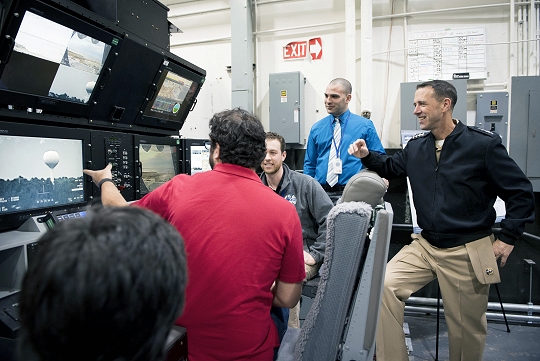 DAHLGREN, Va. (Jan. 18, 2017) Chief of Naval Operations (CNO) Adm. John Richardson visits Naval Surface Warfare Center Dahlgren Division (NSWCDD). During his visit, CNO held and all-hands call, and toured various labs and workspaces including electromagnetic launchers, hypervelocity projectiles, and directed energy weapons. NSWCDD's provides research, development, test and evaluation, analysis, systems engineering, integration and certification of complex naval warfare systems. (U.S. Navy photo by Mass Communication Specialist 1st Class Nathan Laird/Released)
DAHLGREN, Va. (Jan. 18, 2017) Chief of Naval Operations (CNO) Adm. John Richardson visits Naval Surface Warfare Center Dahlgren Division (NSWCDD). During his visit, CNO held and all-hands call, and toured various labs and workspaces including electromagnetic launchers, hypervelocity projectiles, and directed energy weapons. NSWCDD's provides research, development, test and evaluation, analysis, systems engineering, integration and certification of complex naval warfare systems. (U.S. Navy photo by Mass Communication Specialist 1st Class Nathan Laird/Released)DAHLGREN, Va. (Jan. 26, 2017)—New and emerging technologies such as directed energy, cyber engineering, and hypervelocity projectiles are continuously under research, development, test, and evaluation at Naval Surface Warfare Center Dahlgren Division (NSWCDD).
Consequently, Navy scientists and engineers are busy keeping Department of Defense leadership current on the latest technological developments and capabilities.
Within eight days, they briefed Chief of Naval Operations (CNO) Adm. John Richardson, Director of Surface Warfare Rear Adm. Ronald Boxall, and Chief of Naval Research Rear Adm. David Hahn on crucial technologies in NSWCDD laboratories and on the Potomac River Test Range.
The CNO was briefed on electric weapons and cybersecurity technology during his Dahlgren visit Jan. 18.
Richardson saw electric weapons—electromagnetic railgun launcher, hypervelocity projectile, and the high-energy laser—in addition to the battle management system. He was briefed on technical advancements and observed a laser weapon demonstration.
"What brings you here is a sense of mission, a sense of doing something important and the nobility of that cause," CNO told more than 900 Dahlgren civilian and military personnel during an all hands call. "Let's make sure we preserve those attributes. It helps us maintain our competitive edge."
Cyber engineers briefed CNO on USS Secure—a multi-enclave test environment to enable the Navy's development, evaluation, and testing of cybersecurity concepts and technologies to defend mission critical systems at sea and ashore.
Boxall led his delegation from the Office of the Chief of Naval Operations to see technologies developed at NSWCDD that included directed energy, electromagnetic railgun, hypervelocity projectile, cyber security, Tactical Tomahawk missile, mission engineering, and the Combined Integrated Air and Missile Defense-Antisubmarine Warfare Trainer.
Navy officials anticipate closer coordination and an increase in information sharing to support integrated warfighting assessment as a result of Boxall's Jan. 19 tour of NSWCDD.
Hahn led his Office of Naval Research (ONR) delegation to see ONR sponsored technologies developed at NSWCDD—including directed energy and the electromagnetic railgun—throughout his Jan. 12 visit.
The ONR delegation watched engineers fire a hypervelocity projectile from a 5-inch, 62-caliber open mount gun at the Potomac River Test Range.
The hypervelocity projectile is a next-generation, guided projectile capable of completing multiple missions for gun systems such as the Navy 5-inch, 155mm, and future railguns.
NSWCDD scientists and engineers updated the three admirals on the command's complex warfare systems development and integration capabilities, and their efforts to incorporate electric weapons technology into existing and future platforms.
For example, NSWCDD scientists and engineers developed and installed the Laser Weapon System aboard afloat forward staging base-interim USS Ponce (AFSB[I] 15) to operate seamlessly with its ship defense system approximately two years ago.
Ponce Sailors—trained by the Dahlgren team on the Laser Weapon System's operation—reported the weapon performed flawlessly during testing in the Arabian Gulf, including tests conducted in adverse weather conditions of high winds, heat, and humidity.
The Laser Weapon System—a collaborative effort between ONR, Naval Sea Systems Command, Naval Research Laboratory, NSWCDD, and industry partners—hit targets mounted aboard a speeding oncoming small boat during the tests. It also shot down a Scan Eagle unmanned aerial vehicle (UAV) and destroyed other moving targets at sea. Navy video of the testing: www.youtube.com/watch?v=D0DbgNju2wE?
The system is operated by a video-game like controller, and can address multiple threats using a range of escalating options, from non-lethal measures such as optical "dazzling" and disabling, to lethal destruction if necessary. It could prove to be a pivotal asset against asymmetric threats, which include small attack boats and UAVs.
Navy leaders have made directed-energy weapons a top priority to counter asymmetric threats, including unmanned and light aircraft and small attack boats that could be used to deny U.S. forces access to certain areas. High-energy lasers offer an affordable and safe way to target these threats at the speed of light with extreme precision and an unlimited magazine, experts say.
NSWCDD, a Naval Sea Systems Command (NAVSEA) warfare center division, is a premier research and development center which serves as a specialty site for weapon system integration. The command's unique ability to rapidly introduce new technology into complex warfighting systems is based on its longstanding competencies in science and technology, research and development, and test and evaluation.



